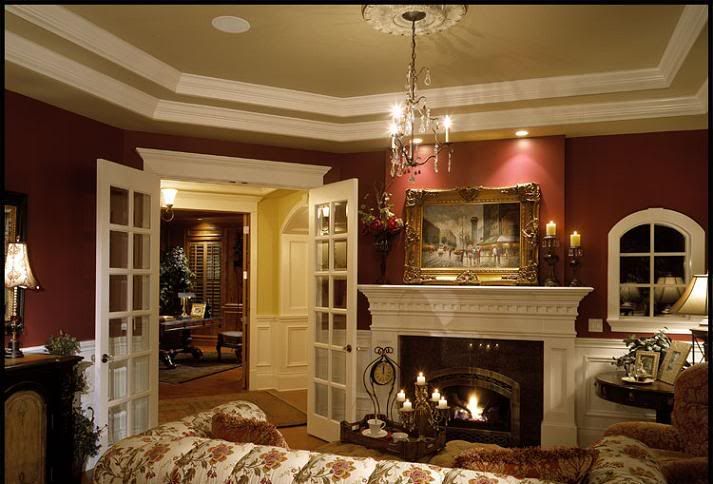Illustration: A W N Pugin Wallpaper design 1840s
The decorative work of Augustus Welby Northmore Pugin is often seen to be a style that was both complex and highly ornamented. While this is true of a certain percentage of his decorative work, particularly that as seen in the Palace of Westminster where overlayering and gilding seemed to rule the day, it would be unfair to say that this was the only contribution made by Pugin to the decorative arts.
The wallpaper design works shown in this article were all produced by Pugin during the 1840s. While these examples were by no means the only wallpaper work produced by Pugin during this period, they do give an indication of perhaps a less formal, or at least less ceremonial, aspect to his style.
Illustration: A W N Pugin Wallpaper design 1840s
These charming and very English motif wallpapers are examples of what was to be known as the Victorian Gothic Revival. Although the Revival itself could appear excessive in certain circumstances, thinking of the Palace of Westminster again, much of the decorative pattern work could often appear in a relatively simplified form. This draws analogies at least with the start of the Reform Movement of the 1850s and onwards, but also that of, if not the styling at least the sentiment and philosophy, William Morris and the later Arts & Crafts movement.
Pugin himself, like all of us, was inconsistent and contradictory. On one level he talked of an early version of what we would see as Form follows Function with the quote: there shall be no features of a building which are not necessary for convenience, construction and propriety. Although this quote does apply specifically to architectural structure and not surface decoration, it does call into question some of his judgements concerning internal decorative schemes, thinking yet again of the Palace of Westminster, which of course stands out before all others in it's over embellishment. However, with caution, we can say that these particular wallpaper designs produced in the 1840s were unusual for British interior decoration.
Illustration: A W N Pugin Wallpaper design 1840s
Many wallpapers of this era tended to overstate their presence with cascades of full blousy flowers, ribbons and other paraphernalia that made walls appear festooned with jungles of impenetrable foliage that bordered on thickets. It was this type of decorative pattern work that the reform movement tried to temper, if not discard altogether. With an individual such as Pugin, the movement had an instant, if inconsistent champion of the merits of a structural vocabulary in the discipline of pattern design and surface decoration in general.
Even Pugin's more complex and heraldic type wallpapers have an underlying and simplified structure and framework to them. This was often missing from many of the more floral representations that were so popular with public, manufacturers and retailers alike. It was this underlying structural simplicity that was such a part of so much of Pugin's output, which makes him stand out as one of the early pioneers of Victorian decorative art and pattern work.
That Pugin died at the ridiculously early age of forty was a particularly tragic loss to the decorative arts of Britain, but also potentially that of both the Reform and the Arts & Crafts movement. By his removal from the design world in 1852, Pugin was unable to contribute towards the changing Victorian world of the 1850s and 1860s which saw the introduction of new art and design schools and colleges, the Reform Movement under Henry Cole and the rise of both William Morris and the Arts & Crafts phenomenon.
Illustration: A W N Pugin Wallpaper design 1840s
Pugin might well have not become a particularly strident supporter of any of the movements and forms that the decorative arts took in Britain during the mid-nineteenth century. He might well have voiced a counter-argument against reform, that would have been his prerogative of course, and probably within his nature to be deliberately both antagonistic and contrary in equal measures. However, if the imagery of the motifs of these simplified and clutter free wallpapers were to continue, Pugin may well have found himself alongside Henry Cole and Owen Jones amongst others, perhaps even championing the causes and ideals that called for some form of tempering and plain speaking within the decorative arts world.
Although there is a decidedly thin line between some of the aspects of Pugin's work, the Reform movement, William Morris and the Arts & Crafts movement, the line is there and Pugin was an inspiration, at least partially, to a number of designers in the decades following his death in 1852. It is these designers who were to take elements of Pugin, along with other examples and influences, and were able to transform British decoration and pattern work into a truly unique phenomenon that was to influence and mould much of the rest of the Victorian era in both Britain and indeed much further afield.
Reference links:
A. W. N. Pugin: Master of Gothic Revival
A.W.N. Pugin: An Annotated Critical Bibliography
Contrasts and True Principles
The Present State of Ecclesiastical Architecture
An Oak Kneehole Desk by A.W.N Pugin (1812-1852) Giclee Poster Print by Alvar Aalto, 9x12
The Stained Glass of A.W.N. Pugin
The Collected Letters of A. W. N. Pugin: Volume I: 1830-1842 (Collected Letters of A.W.N. Pugin)
The Collected Letters of A. W. N. Pugin: Volume 2: 1843-1845 (Collected Letters of A.W.N. Pugin)
The Collected Letters of A. W. N. Pugin: Volume 3: 1846-1848 (C Clpug T Collected Letters of)
Pugin-land: A.W.N.Pugin, Lord Shrewsbury and the Gothic Revival in Staffordshire






















No comments:
Post a Comment